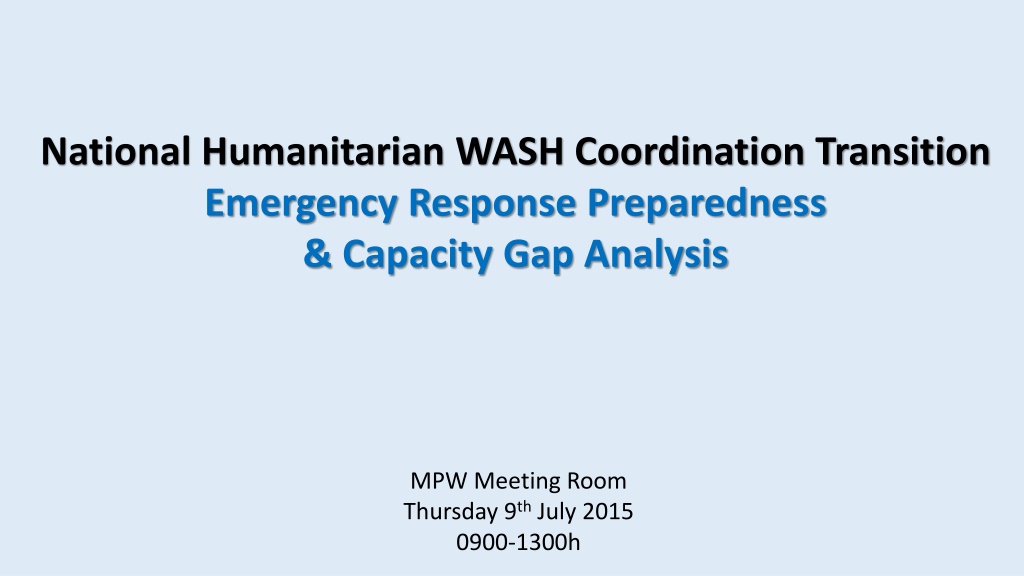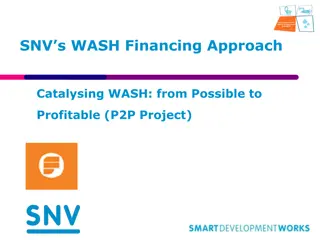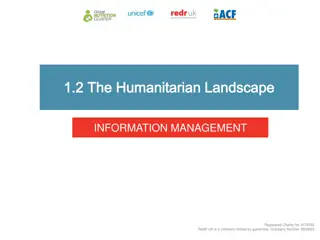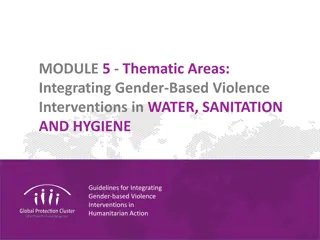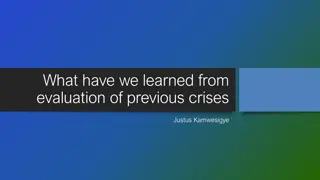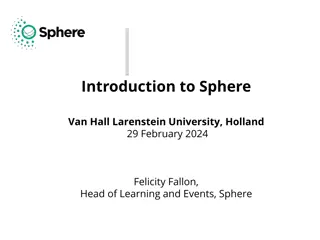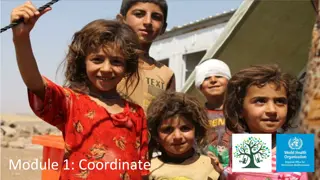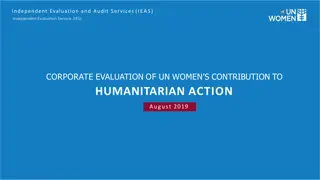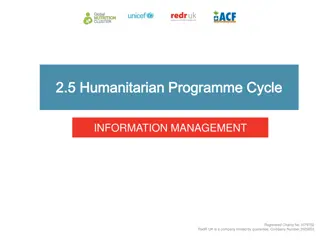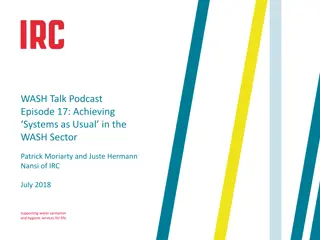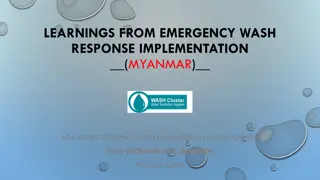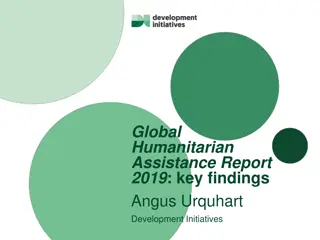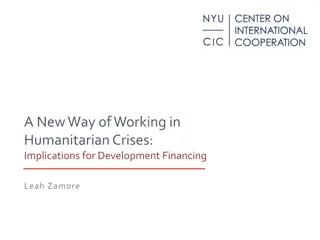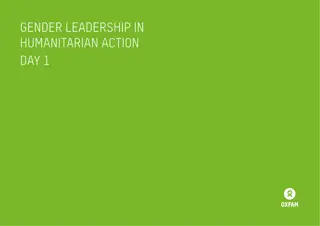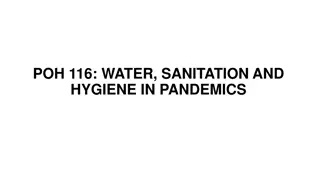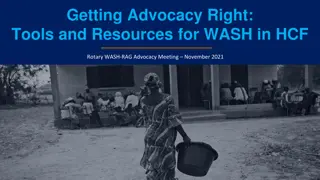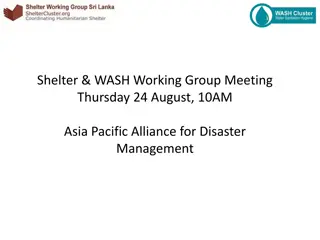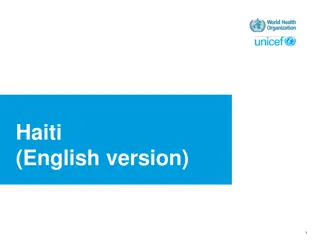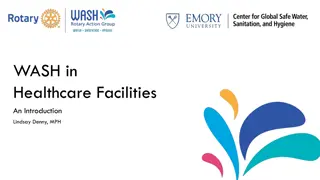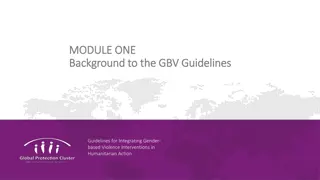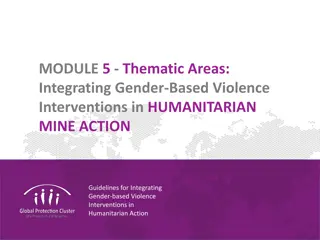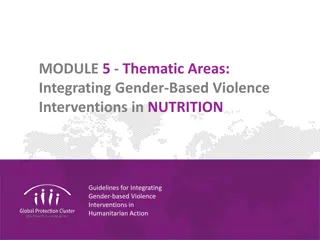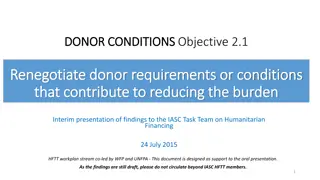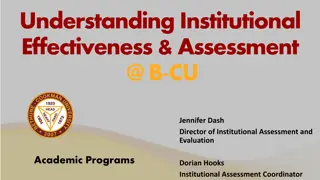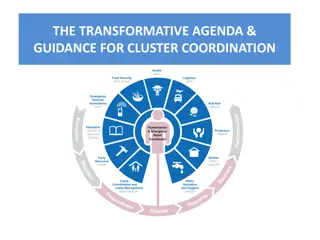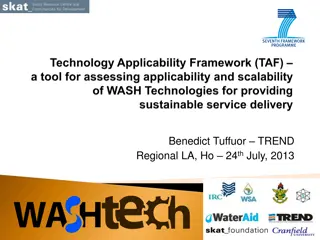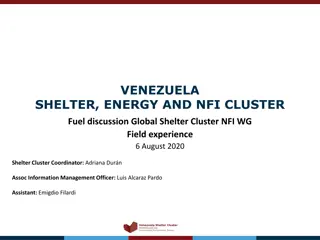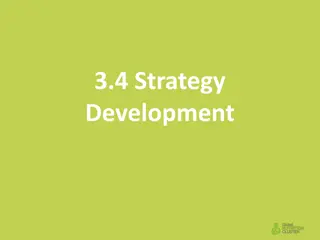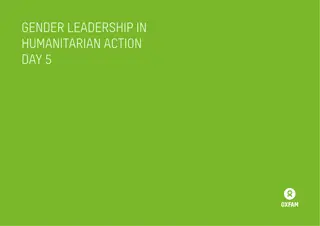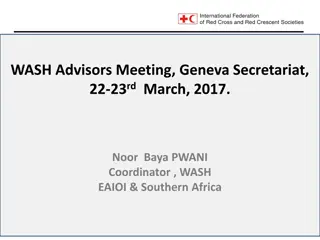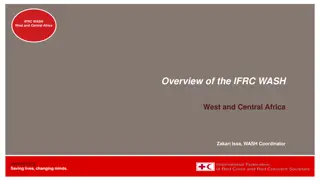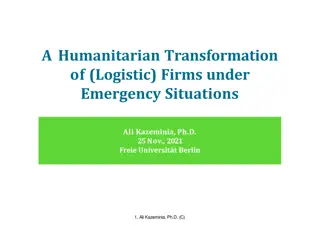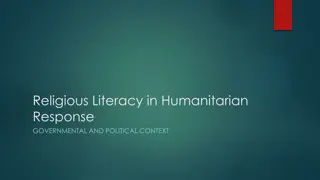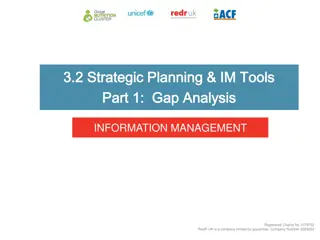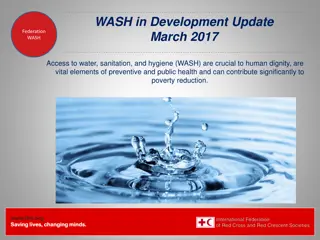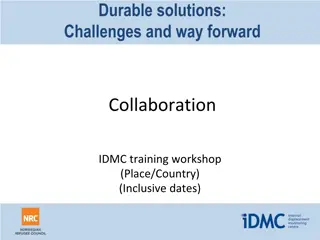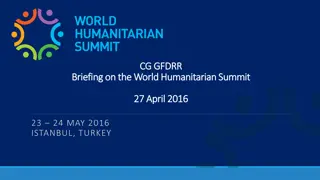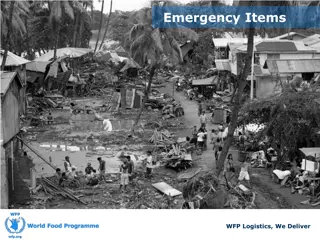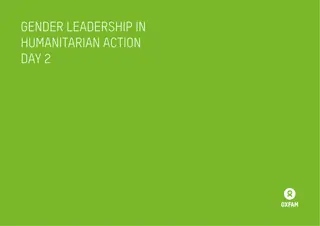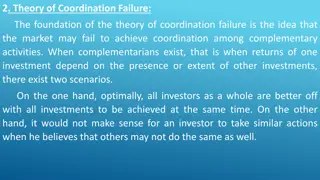Challenges and Institutional Needs in Humanitarian WASH Coordination
Lack of clarity in donor roles, structural fund limitations, weak advocacy, and poor political engagement are hindering WASH coordination efforts. Key institutional challenges include inadequate resources, mandate conflicts, and limited capacity at national and sub-national levels, impacting the Ebola response and long-term WASH sustainability. Transition assessment highlights social conflicts, equity issues, community skills, and donor commitment as key drivers in the WASH coordination domain.
- WASH coordination
- institutional challenges
- humanitarian response
- capacity gaps
- transition assessment
Download Presentation

Please find below an Image/Link to download the presentation.
The content on the website is provided AS IS for your information and personal use only. It may not be sold, licensed, or shared on other websites without obtaining consent from the author. Download presentation by click this link. If you encounter any issues during the download, it is possible that the publisher has removed the file from their server.
E N D
Presentation Transcript
National Humanitarian WASH Coordination Transition Emergency Response Preparedness & Capacity Gap Analysis MPW Meeting Room Thursday 9th July 2015 0900-1300h
Lack of clarity of roles of Donors and their links with the Coordination Platform Limited structural funds Weak advocacy by sector to influence Donor investment policies and practice Weak political engagement of the WASH sector Limited authority to influence partner responses Lack of follow-up or commitment of partners & Donors towards the response plan Low WASH sector visibility in the Annual Planning process (Focus on Health) Loss of linkages between WASH sector and other sectors Weak Information Management Trust deficit on the National Platform for EVD Poor service delivery & Response Inflexibility of the response plan versus the situation dynamics Low resource availability for WASH Coordination Fragmented sector Government capacities (HR, Financial, Technical) is limited Lowest capacity at Sub-National levels Absence of Emergency Preparedness & Response Plan LIBERIA NHWCT Challenges (April 2015)
Key Institutional Challenges Current EVD response not addressing long term ERP and DRR capacity needs Current humanitarian action is failing to direct critical HR, technical and financial resources towards the National WASH Coordination platform Established NDMC is under-resourced and virtually non-functional WASH profile within EVD response remains low among political circles Mandate conflicts & intense safeguarding of respective mandates is limiting cross-sectoral collaboration Insufficient staff with appropriate skill set at national and sub-national levels to Coordinate humanitarian WASH interventions Short termist approach of donors mitigating against sustainable WASH services
National Humanitarian WASH Coordination Transition Assessment Framework Domain Determinant Key Issue Drivers History of Social Conflict & marginalisation of minority groups Equity mapping of WASH service access Social cohesion evidenced by community level organisational skills & volunteerism DRR implementation progress Humanitarian performance of State sector structures Humanitarian impact of prior disasters Respect for humanitarian principles among non-state actors Civil-Military Liaison support available to WASH as enabling last resort mechanism Govt/Donor commitment to addressing underlying causes of vulnerability leading to poor WASH service access Transition planning initiative by HCT Cluster Learning Practices Depth of engagement between Cluster/Sector Coordination fora Capacity generated within Sector institutions by prior Cluster deployments Degree of fragmentation & decentralisation among WASH institutions Proportion of WASH services delivered by Govt/NGO s Progress with Sector-wide Programme implementation Cluster transition/harmonisation process initiated by HCT + Govt Synergy between sectoral humanitarian & development actions in UNDAF and Transitional Appeal frameworks Effectiveness of inter-sectoral coordination in Govt. Key gaps in Cluster/Sector capacity for humanitarian action WASHiE training record and trends for Cluster & sector personnel HR performance monitoring framework & evaluation/audit follow-up record on capacity issues Partner willingness & ability to respond to calls for information sharing ICT innovations with data capture, transfer and analysis + sustainable web site host for dissemination Govt policy w.r.t sector related information management Funding impacts on supply planning and inventory management Capacity building trends for supply & procurement services Need to improve Govt supply/procurement efficiency & transparency Formulation and dissemination of international humanitarian WASH standards and operational best practices by Global Cluster/IASC Commitment to harmonise national WASH service standards with international humanitarian norms Desire for independent beneficiary satisfaction feedback & empowerment Political, Economic & Social Context Enabling Environment Evolution of Humanitarian Needs & Hazard Trends Financial Resource Mobilisation Trends & Non- Specialist Liaison Cluster/Sector Coordination & Activation Status Institutional & Regulatory Environment Mapping of Sector Institutional Structures & Regulatory Framework Inter Cluster & Inter-Sectoral Coordination Capacity & Services Human Resource Capacity for Cluster/Sector Humanitarian Action Cluster/Sector Information Management Capacity Supply/procurement service Policy & Practice Alignment between national & international humanitarian action norms Quality Standards
Humanitarian WASH Coordination Transition Checklist
Fundamental Requirements of a WASH Emergency Response Preparedness (ERP) Plan Alignment & periodic update of WASH ERP with other existing emergency preparedness plans (eg. Municipal, Security, Health Plans etc.) Clear Organisational Structure Competent people Adequate asset & resource management Clearly accountable & Effective Procedures Political Support Effective Public Advocacy & Communication
Basic ERP Elements: Hazard/Risk Ranking & Early Warning Risk Analysis & Monitoring Establish Procedures & Structures Minimum Preparedness Action (MPA) Build on MPA s tailored to specific risk scenarios with high/medium threats (May include Simulation exercises) Advanced Preparedness Actions & Contingency Planning Operates at 3 levels: Inter-Agency : Sector Specific: Organisation Specific: Broad framework for collaboration, information sharing, priority setting Guides mobilisation of Sector actors in meeting agreed sectoral goals Describes how services will be delivered and sustained https://www.humanitarianresponse.info/system/files/documents/files/Emergency_preparedness_guidance-24Oct2014.pdf
Risk = Impact x Likelihood WASH Context: Organisational Risk Assessment HR management of Specialist Capacity Reporting lines and Accountability Mobility/Access to areas of potential need 4W Mapping of partners & their capacities Information exchange systems ERP Updating frequency WASH System Risk Assessment Examine vulnerable system components Potential impact of system failure on users Contingency stock of essential parts/materials Feasibility of Packaged interventions Resources for contingency stocks Prioritisation of Risks
ERP Organisational Structure for EVD Response (Work-in-progress) Source: NWSHPC Capacity Resources Adaptability Prioritisation
Group Work Operations (Assessment & Site Selection; Technical Design; Project Supervision; Quality Assurance) Planning (National Coordination; ERP Planning; Needs Assessment; M&E; Resource Mobilisation) Information - Communication (Media advocacy; Public Relations; ICT systems; Data Analysis) Logistics (Vehicle fleet operation/maintenance; Air Logistics; Warehousing; Set-packing of Kits) Finance/Administration (Procurement; Contracting; Costing; Payroll; Documentation; Legal) 1. What specific roles do you want to see the National WASH Platform playing ? Please Prioritise 2. What skills/attitudes are required for each of these roles ? 3. Who could provide support in strengthening these skill sets and How ? 4. When should this happen (over the next two years) ?
National Humanitarian WASH Coordination Transition Methodological Framework Global Templates for Reference
Methodological Process for Strengthening National Humanitarian WASH Coordination 1/4 Domain Determinant Key Drivers Key Bottlenecks Causes of Mitigating Actions Indicators of Progress Bottlenecks History of Social Conflict & marginalisation of minority groups Equity mapping of WASH service access Social cohesion evidenced by community level organisational skills & volunteerism Persistent vulnerability in areas experiencing repeated shocks and disasters Political marginalisation of population groups living in vulnerable areas Insufficient investment/capacity in EWS/affected area infrastructure Poor access due to insecurity and/or poor infrastructure Weak influence/ coping capacity of affected communities Proportion of investment targeted to areas with persistent vulnerability Recovery rate of affected populations with respect to basic WASH services Political, Economic & Social Context Identify areas of recurring vulnerability and intensify advocacy to build stronger early warning, improved access and strengthened coping capacity support for affected communities in these areas. Enabling Environment DRR implementation progress Humanitarian performance of State sector structures Humanitarian impact of prior disasters Weak technical and management capacity of sector partners at decentralised levels Poorly articulated DRR mainstreaming strategy Weak HR, finance & poor conditions of service at decentralised levels Weak engagement of WASH sector from DRR mainstreaming processes Cross-participation of WASH sector & DRR specialists in respective coordination forums Number of WASH staff trained in DRR mainstreaming Humanitarian Needs and Hazard Trends Build on capacity within institutional structures coordinating DRR for disaster resilient WASH development actions and support DRR mainstreaming efforts within the WASH sector. Respect for humanitarian principles among non-state actors Civil-Military Liaison support available to WASH as enabling last resort mechanism Govt/Donor commitment to addressing underlying causes of vulnerability leading to poor WASH service access Security threats undermine access to deliver services in highly vulnerable areas Humanitarian donor reluctance to support long term stabilisation efforts Breakdown of political accord between Govt and opposing entities Short term funding cycle of humanitarian donors Proportion of multi- year funding for institutional capacity building in highly vulnerable areas Effectiveness of WASH stabilisation measures applied in areas with persistent insecurity Sector Financial management /Investment Trend & non-state actor liaison Intensify advocacy for longer term stabilisation funding targeted to areas with persistent vulnerability and capacity building for coordination functions in Govt related to DRR and humanitarian WASH action.
Methodological Process for Strengthening National Humanitarian WASH Coordination 2/4 Domain Determinant Key Drivers Key Bottlenecks Causes of Bottlenecks Mitigating Actions Indicators of Progress Transition planning initiative by HCT Cluster Learning Practices Depth of engagement between Cluster/Sector Coordination fora Capacity generated within Sector institutions by prior Cluster deployments Delayed or weak HCT leadership on transition planning exercise Superficial contact between Cluster and Government Sector personnel from crisis outset Capacity gaps generated by funding constraints for international CC s & double-hatting of UNICEF WASH Emergency staff Reluctance to embed humanitarian Cluster staff within sector institutions Leadership & progress of transition planning initiation by HCT/IC Group + Govt engagement Integration of Cluster management team within Sector Ministry Cluster and Sector Coordination Activation Status Ensure HCT/Inter- Cluster group initiates transition dialogue with Government from crisis onset and embed WASH Cluster staff within Sector structures as early as possible. Institutional & Regulatory Environment Degree of fragmentation & decentralisation among WASH institutions Proportion of WASH services delivered by Govt/NGO s Progress with Sector-wide Programme implementation Mandate conflict between agencies in government with joint accountability for WASH Faltering sector-wide reform process Weak organisational management and consensus building skills in key Govt agencies Sector wide reform driven by donors but lacking political will of Government Humanitarian Coordination platform functioning in reformed Sector institutional structure Timely & substantial partner participation in coordination fora at all levels Sector Institutional Structures & Regulatory Framework Support capacity building for coordination platforms at all decentralised levels of WASH sector wide programmes to harmonise SOP s with NGO s & unify fragmented sector Cluster transition/harmonisation process initiated by HCT + Govt Synergy between sectoral humanitarian & development actions in UNDAF and Transitional Appeal frameworks Effectiveness of inter-sectoral coordination in Govt. Pre-occupation with mobilising humanitarian response system and needs assessment. Mandate rivalries between sectors of Government and inflexible protocols. Imbalance in the distribution of resources in favour of those providing the humanitarian assistance Vertical line management practice in government and weak accountability structures Use of multi-cluster needs assessment tools by all partners Simulation exercise practice and learning culture adopted by sector partners Articulation of multi- sectoral actions impacting WASH outcomes in UNDAF Inter-Cluster/Sector Coordination Early engagement in transition planning under HCT leadership and use joint needs assessments and simulation exercises to forge mutual understanding between humanitarian actors and Government agencies
Methodological Process for Strengthening National Humanitarian WASH Coordination 3/4 Domain Determinant Key Drivers Key Bottlenecks Causes of Bottlenecks Mitigating Actions Indicators of Progress Key gaps in Cluster/Sector capacity for humanitarian action WASHiE training record and trends for Cluster & sector personnel HR performance monitoring framework & evaluation/audit follow-up record on capacity issues Demanding skill sets required for effective Coordination with national entities. Prioritisation of WASHiE training for NGO/UN staff over national partners. Insufficient profiling of candidates for Coordination roles. Unfamiliarity with role designations in Government for humanitarian WASH due to high turn over Revised ToR s for WASH Coordinators incorporating transition functions National partners trained in WASHiE Govt HR performance monitoring addresses humanitarian career growth incentives Human Resource Capacity for Cluster/Sector Coordination Revise profile of humanitarian WASH coordinator candidates to include skill sets appropriate for liaison transition planning with Govt & improve skills & career development pathway for incumbents Capacity & Services Partner willingness & ability to respond to calls for information sharing ICT innovations with data capture, transfer and analysis + sustainable web site host for dissemination Govt policy w.r.t sector related information management Compatibility problems between UN info capture tools and NGO/Govt info systems. Limited info sharing technology investment within Govt and restrictions on data publication UN system firewall & use of incompatible software/hardware. Limited learning & reflection by all humanitarian stakeholders with Government Projectised capture of Govt info systems Information sharing practice of humanitarian WASH partners Compatibility of Cluster/Sector IM tools Govt Policy changes supporting free info access & publication Cluster/Sector Information Management Practice Develop policies, IM tools and promote investment in software/hardware which optimises the exchange of data between NGO/UN actors and Government and public input/access to these systems. Funding impacts on supply planning and inventory management Capacity building trends for supply & procurement services Need to improve Govt supply/procurement efficiency & transparency Importation & logs management for pre- positioning of essential WASH supplies Weak capacity & transparency for WASH services procurement in Government High import tariffs on humanitarian WASH goods & high inland transportation costs Limited and fragile local service procurement market tempts corrupt practice Procurement turn- around improved Capacity building investment targeted to strengthen procurement capacity Local market able to sustain high intensity procurement Supply & Procurement Practice Advocate for concessionary humanitarian WASH procurement systems within sector wide capacity building efforts & monitor to ensure system is driven by needs and local market realities (not by available funding)
Methodological Process for Strengthening National Humanitarian WASH Coordination 4/4 Domain Determinant Key Drivers Key Bottlenecks Causes of Bottlenecks Mitigating Actions Indicators of Progress Formulation and dissemination of international humanitarian WASH standards and operational best practices by Global Cluster/IASC Commitment to harmonise national WASH service standards with international humanitarian norms Desire for independent beneficiary satisfaction feedback & empowerment Lack of operational procedures framework between Government and all humanitarian actors which defines minimum service standards, indicators and means of verification. Limited beneficiary feedback mechanisms to support service level verification efforts Limited dialogue between Government and UN/NGO actors on defining national humanitarian WASH minimum standards. Limited capacity for monitoring attainment and means of enforcing quality of service standards Dynamics of change among crisis affected populations overwhelms efforts to attain minimum service levels Promote dialogue on adoption of humanitarian WASH quality standards aligned with international norms and make routine use of global standards and operational guidance available via the washcluster.net website, including translation into local majority languages where required. Advocate and support the establishment of beneficiary feedback mechanisms to inform improvement of WASH operational practices Degree of alignment between Cluster and Sector humanitarian service and process norms Public access to international norms and standards (including appropriate reference translations where relevant) Public feedback on quality and timing of humanitarian WASH support and remedial actions taken. Alignment between national & international humanitarian WASH service norms Quality Standards
